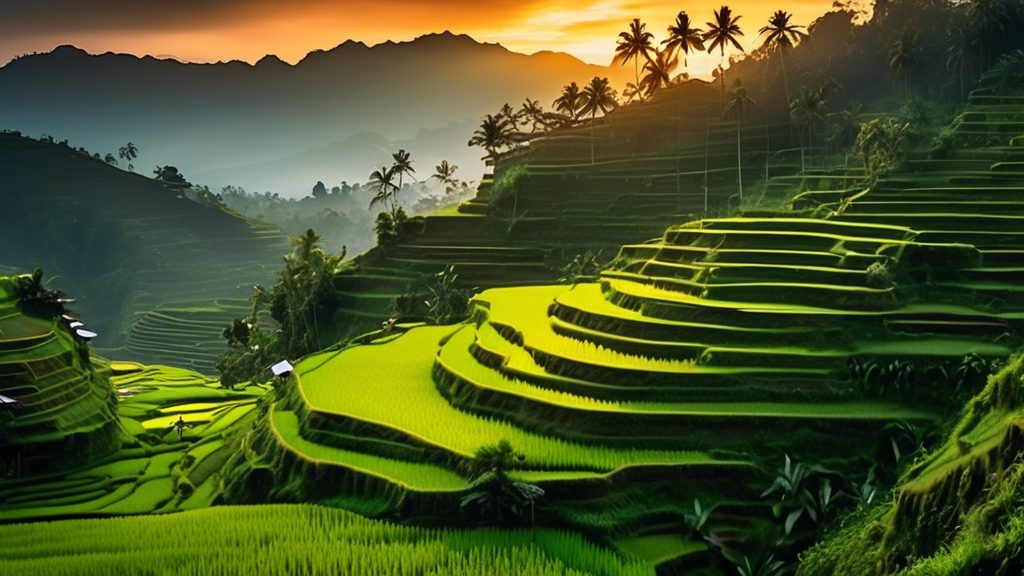Bali, the enchanting Indonesian island known for its lush landscapes and rich cultural heritage, offers travelers a multitude of breathtaking experiences. Among these, exploring Bali’s iconic rice terraces stands out as a scenic adventure that showcases the harmony between nature and human ingenuity. The terraced fields, a quintessential element of Bali’s landscape, are not only a testament to the island’s agricultural prowess but also an invitation to immerse oneself in its serene beauty.
The History and Cultural Significance
Bali’s rice terraces are more than just picturesque landscapes; they are a reflection of the island’s deep-rooted cultural and religious traditions. Rice cultivation in Bali follows the Subak irrigation system, an ancient method that dates back to the 9th century. This community-based system is a manifestation of the Balinese Tri Hita Karana philosophy, which emphasizes the interconnectedness of humans, nature, and the spiritual realm. The Subak system has been recognized by UNESCO, affirming its importance as part of Bali’s cultural heritage. Visitors to the rice terraces will not only see stunning scenery but also gain insight into the harmonious way the Balinese live in balance with their environment.
Top Rice Terraces to Visit
Tegallalang Rice Terraces
The Tegallalang Rice Terraces, located just a short drive north of Ubud, are arguably the most famous and frequently photographed of Bali’s rice fields. The steeply sloped terraces, lush greenery, and flowing streams create a mesmerizing vista. Visitors can enjoy leisurely walks along the pathways, which offer numerous vantage points for capturing the perfect shot. The area is also dotted with quaint cafes where one can relax while savoring the view.
Jatiluwih Rice Terraces
For those seeking a more expansive and less crowded experience, the Jatiluwih Rice Terraces in Tabanan are an excellent choice. Spanning over 600 hectares, these terraces offer vast panoramic views of undulating rice fields set against the backdrop of majestic mountains. Jatiluwih remains relatively unspoiled by tourism, providing a more authentic and tranquil experience. Here, visitors can explore various trails and partake in local guided tours to learn about traditional farming practices.
Sidemen Valley
Located in the eastern part of Bali, the Sidemen Valley is a hidden gem that offers a quieter and more intimate encounter with the island’s rice terraces. The valley’s terraced hillsides are interwoven with small villages, lush forests, and meandering rivers, creating a captivating mosaic of natural beauty. This area is ideal for those seeking to combine their rice terrace exploration with hiking, river activities, and cultural immersion in local Balinese life.
Experiencing the Rice Terraces
Exploring Bali’s rice terraces is not only about admiring their beauty from a distance; it involves engaging with the landscape and its people. Many rice terraces offer guided tours where visitors can learn about the rice-growing process, from planting to harvesting. These tours often include hands-on activities such as planting rice seedlings or traditional plowing with water buffaloes, providing a deeper understanding of the labor and skill involved in rice cultivation.
Another way to experience the rice terraces is by participating in a trekking tour. Walking through the terraces allows travelers to fully absorb the tranquility and splendor of the surroundings. These treks often lead through charming villages, where one can witness local customs and perhaps even enjoy a traditional Balinese meal with a farming family.
Best Time to Visit
While Bali’s rice terraces are beautiful year-round, the best time to visit often depends on the stage of the rice-growing cycle and the weather. The fields are most vibrant and green during the planting and growing season, typically between March and April and again in October to December. These periods offer lush, green landscapes that are perfect for photography and exploration.
For those interested in witnessing the rice harvest, visiting during the dry season, from May to September, can be particularly rewarding. The golden hues of the ripened rice create a different, yet equally stunning, scene.
Conclusion
Exploring Bali’s rice terraces is a journey through one of the most picturesque and culturally rich landscapes on the island. From the famous Tegallalang to the expansive Jatiluwih and the serene Sidemen Valley, each terrace offers its unique charm and beauty. Whether through leisurely strolls, guided tours, or immersive trekking experiences, visitors to these terraces will leave with a deeper appreciation for Bali’s agricultural heritage and the intricate balance its people maintain with their natural environment.


